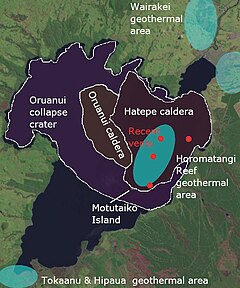| Hatepe eruption | |
|---|---|
| Volcano | Lake Taupō |
| Date | About 230 CE |
| Type | Phreatomagmatic, ultra-Plinian |
| Location | Lake Taupō, North Island, New Zealand 38°49′S 175°55′E / 38.817°S 175.917°E |
| VEI | 7 |
| Impact | Devastated vegetation in region, expanded Lake Taupō, flooded the Waikato River |
 | |
The Hatepe eruption, named for the Hatepe Plinian pumice tephra layer,[1] sometimes referred to as the Taupō eruption or Horomatangi Reef Unit Y eruption, is dated to 232 CE ± 10[2] and was Taupō Volcano's most recent major eruption. It is thought to be New Zealand's largest eruption within the last 20,000 years. The eruption ejected some 45–105 km3 (11–25 cu mi) of bulk tephra,[3] of which just over 30 km3 (7.2 cu mi) was ejected in approximately 6–7 minutes.[4] This makes it one of the largest eruptions in the last 5,000 years, comparable to the Minoan eruption in the 2nd millennium BCE, the 946 eruption of Paektu Mountain, the 1257 eruption of Mount Samalas, and the 1815 eruption of Mount Tambora.
- ^ Talbot, J. P.; Self, S.; Wilson, C. J. N. (1994). "Dilute gravity current and rain-flushed ash deposits in the 1.8 ka Hatepe Plinian deposit, Taupo, New Zealand". Bulletin of Volcanology. 56 (6–7): 538–551. Bibcode:1994BVol...56..538T. doi:10.1007/BF00302834. S2CID 129632427.
- ^ Illsley-Kemp, Finnigan; Barker, Simon J.; Wilson, Colin J. N.; Chamberlain, Calum J.; Hreinsdóttir, Sigrún; Ellis, Susan; Hamling, Ian J.; Savage, Martha K.; Mestel, Eleanor R. H.; Wadsworth, Fabian B. (1 June 2021). "Volcanic Unrest at Taupō Volcano in 2019: Causes, Mechanisms and Implications". Geochemistry, Geophysics, Geosystems. 22 (6): 1–27. Bibcode:2021GGG....2209803I. doi:10.1029/2021GC009803.
- ^ Sutton, Andrew N.; Blake, Stephen; Wilson, Colin J. N. (1995-10-01). "An outline geochemistry of rhyolite eruptives from Taupo volcanic centre, New Zealand". Journal of Volcanology and Geothermal Research. Taupo Volcanic Zone, New Zealand. 68 (1): 153–175. Bibcode:1995JVGR...68..153S. doi:10.1016/0377-0273(95)00011-I. ISSN 0377-0273.
- ^ Wilson, CJN (1985-06-28). "The Taupo eruption, New Zealand. II. The Taupo Ignimbrite". Philosophical Transactions of the Royal Society of London. Series A, Mathematical and Physical Sciences. 314 (1529): 229–310. Bibcode:1985RSPTA.314..229W. doi:10.1098/rsta.1985.0020. ISSN 0080-4614. S2CID 123039394.